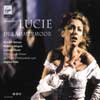Donizetti Lucie de Lammermoor
Lucia in French, curiously adapted but with fine leads in Dessay and Alagna
View record and artist detailsRecord and Artist Details
Composer or Director: Gaetano Donizetti
Genre:
Opera
Label: Virgin Classics
Magazine Review Date: 1/2003
Media Format: CD or Download
Media Runtime: 127
Mastering:
Stereo
DDD
Catalogue Number: 545528-2

Tracks:
| Composition | Artist Credit |
|---|---|
| Lucie de Lammermoor |
Gaetano Donizetti, Composer
Evelino Pidò, Conductor Gaetano Donizetti, Composer Ludovic Tézier, Henri, Baritone Lyon Opera Chorus Lyon Opera Orchestra Marc Laho, Sir Arthur, Tenor Natalie Dessay, Lucie, Soprano Nicolas Cavallier, Raimond, Bass Roberto Alagna, Edgard, Tenor Yves Saelens, Gilbert, Tenor |
Author: Patrick O'Connor
The whims of 19th-century prima donnas take a lot of explaining. Early on in Lucia’s career in Italy, Donizetti found that sopranos didn’t like the Act 1 cavatina, ‘Regnava nel silenzio’, and he allowed it to be replaced by another aria and cabaletta, ‘Perchè non ho’, from Rosmonda d’Inghilterra (the opera he had composed for Florence in 1834, the year before the première of Lucia in Naples). It’s a pleasant enough aria, but by losing all the story of Lucy seeing the ghost by the fountain (the subject of ‘Regnava’), the references later in the Mad Scene to this become meaningless. Similarly, as the Rosmonda aria is accompanied by a flute, that spoils the effect of the flute’s entry later in the opera.
When Lucia was translated into French to become Lucie, for the Théâtre de la Renaissance in Paris in 1839 (not the theatre of that name we know today, but a quite different venue in the Rue Neuve-Ventadour), this transposed aria was kept, and the opera was shortened. The Lucy-Raimond duet was excised, as was the character of Lucy’s companion, Alisa. It’s all rather strange, and it’s difficult to believe that Donizetti actually wanted these changes, rather that they were forced on him by the managementand its stars. This French Lucie continued to be performed into the 1900s – Lucette Korsoff recorded the replacement aria in 1913 (reissued on IRRC, 8/92).
Lucie – the earlier one, live from the Martina Franca Festival in 1997, has a lot of spirit, but is inevitably overshadowed by this new studio version, recorded after a series of performances at the Lyon Opera in 2002. Natalie Dessay is a Lucy in the tradition of Lily Pons, a light soprano rather than the more dramatic character we have become used to in the performances of Callas and Sutherland. She phrases ‘A toi ma vie’ (‘Alfin son tua’) with real feeling, and takes the lower options at the climax of this and the sextet, which subsequently rather fails to make its usual impact.
Roberto Alagna is a fine Edgard; both the Wolf’s Crag duet – with Ludovic Tézier as Henry – and the tomb scene go well. For dramatic effects Alagna has taken to using a rather ‘throaty’ quality, which was never evident in his earlier recordings. I hope it is for effect, and not the result of singing too many Manricos and Don Josés. Nevertheless, ‘Tombe de mes aieux’ is the high point of the proceedings.
Evelino Pidò directs a mostly restrained reading, with little of the white heat that Schippers brings to it in the recently reissued Westminster set with Sills and Bergonzi (10/02). As for the Rosmonda aria, it is so much more appropriate in its original context, with a middle section as a duet for two sopranos, as can be heard in Renée Fleming’s performance on Opera Rara (6/01). Lucie is such a curiosity, that I’m glad to have heard it, but it makes one admire the original Lucia all the more.
When Lucia was translated into French to become Lucie, for the Théâtre de la Renaissance in Paris in 1839 (not the theatre of that name we know today, but a quite different venue in the Rue Neuve-Ventadour), this transposed aria was kept, and the opera was shortened. The Lucy-Raimond duet was excised, as was the character of Lucy’s companion, Alisa. It’s all rather strange, and it’s difficult to believe that Donizetti actually wanted these changes, rather that they were forced on him by the managementand its stars. This French Lucie continued to be performed into the 1900s – Lucette Korsoff recorded the replacement aria in 1913 (reissued on IRRC, 8/92).
Roberto Alagna is a fine Edgard; both the Wolf’s Crag duet – with Ludovic Tézier as Henry – and the tomb scene go well. For dramatic effects Alagna has taken to using a rather ‘throaty’ quality, which was never evident in his earlier recordings. I hope it is for effect, and not the result of singing too many Manricos and Don Josés. Nevertheless, ‘Tombe de mes aieux’ is the high point of the proceedings.
Evelino Pidò directs a mostly restrained reading, with little of the white heat that Schippers brings to it in the recently reissued Westminster set with Sills and Bergonzi (10/02). As for the Rosmonda aria, it is so much more appropriate in its original context, with a middle section as a duet for two sopranos, as can be heard in Renée Fleming’s performance on Opera Rara (6/01). Lucie is such a curiosity, that I’m glad to have heard it, but it makes one admire the original Lucia all the more.
Discover the world's largest classical music catalogue with Presto Music.

Gramophone Digital Club
- Digital Edition
- Digital Archive
- Reviews Database
- Full website access
From £8.75 / month
Subscribe
Gramophone Full Club
- Print Edition
- Digital Edition
- Digital Archive
- Reviews Database
- Full website access
From £11.00 / month
Subscribe
If you are a library, university or other organisation that would be interested in an institutional subscription to Gramophone please click here for further information.




